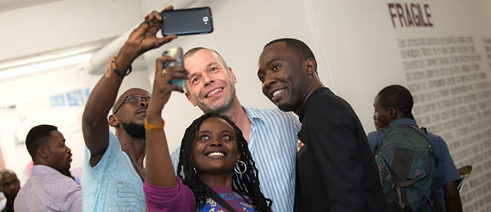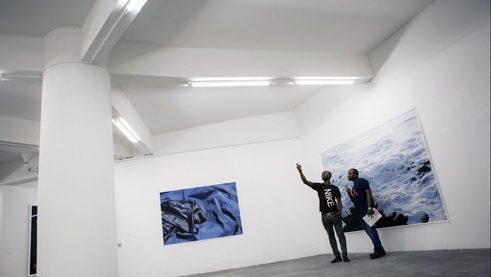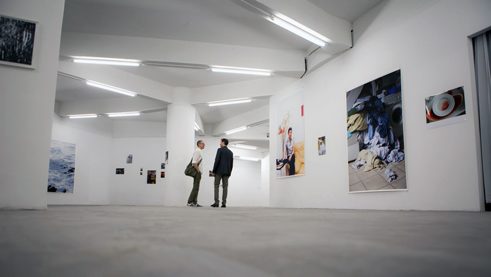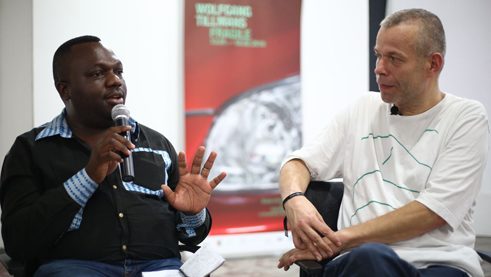Wolfgang Tillmans in Kinshasa
A picture of the times

For the first time, a solo exhibition by Wolfgang Tillmans can be seen on the African continent. Entitled Fragile, it opened in Kinshasa on 12 January 2018 in the presence of the artist. In an interview with Patrick Mudekereza, Tillmans talks about his impressions of the first station of the ifa touring exhibition, which is realised in cooperation with the Goethe-Institut Kinshasa.
Mr Tillmans, you have shown your work in many countries around the world. What does this tour of Africa stand for, in particular the first stop in Kinshasa?
I work to communicate with people. I chose photography as a medium because I can speak better with it than with words. Photography travels well; it travels on printed pages, today of course also on the Internet. An exhibition in a room, in a gallery, on the other hand, is a unique experience. This way, I can create a holistic experience in a museum, three-dimensional and within time limits. The time I spend with the installation is very intense and I can feel every square metre of the gallery. I spent seven days and nights in the museum in Kinshasa and in the gallery at the academy. Now I am about to leave Kinshasa, but I hope that the spirit of the exhibition remains; that people can visit the exhibition and follow my way of thinking about the exhibition.
I believe that cultural exchange is very important. In Europe, we see a lot of musicians and artists from Africa, but it’s my impression that there are not many ambitious exhibitions by European artists in Africa. I toured North and South America in recent years, and then decided I would like to visit a continent that I don’t know at all. So this visit is not just about me showing people something, but also about learning about the Congo and getting to know it better. I also took pictures here, which I hope will be incorporated in my work and thus represent an aspect of the Congo.
Photography is democratic
The exhibition is taking place in two locations: the Museum of Contemporary Art and Multimedia and the Academy of Fine Arts. There are posters and large advertisements with your pictures throughout the city and the exhibition is also accompanied by a publication. Is photography something that you want to share with people who never go to exhibitions?Photography is easily reproducible in various media. I myself also like to see photos in magazines or on album covers, not just in rooms where art is exhibited. Photography is therefore democratic, which gives it a lot of power. So the catalogue, the posters and the big billboards can be seen by people who have not made an active decision to go to the museum. Maybe someone who is not interested in art will find the publication in someone’s home. The dissemination of my work is an important aspect of my production.
While speaking with the students of the academy, you said that every wall, every empty space in the museum should be understood as part of the exhibition. What is your relationship to surfaces and architecture?
For me, photography is a three-dimensional medium. I think everything in three dimensions and translate it into two dimensions. You don’t often think about this translation, but for me it is central because I look with my eyes. I have two of them, which is why I can see spatially. I show sculptural situations in my photos. For example, a large work of a weed, an oddly panoramic work that you can travel in the space with your eyes when you stand in front of it. I installed the work on a freestanding wall, and immediately you have the illusion of this object in the three-dimensional space of the museum. The museum on the Echangeur has spectacular architecture. The room is round, with walls that radiate away from the centre. There are lots of perspectives to discover. At the centre, I placed a video installation showing a total solar eclipse. It’s fun to use every corner of this architecture that dates back to the 1970s. The Goethe-Institut helped fund the renovation of the space with new neon lights and additional walls. I’m glad that the rooms have been transformed and are gaining new glory. I hope the new space brings life to the very active cultural scene of Kinshasa.
The exhibition sometimes gives you the feeling of being on a scavenger hunt, as there are some photos that are hidden or placed high up on the wall or on the pillars. What advice can you give visitors who come to the museum?
There’s not just one way to enter the exhibition; it’s not linear but spatial. You can go through quickly and go out slowly again. Visitors shouldn’t wonder what the artist is trying to say. There is no key, but I would like to encourage them to use their own eyes without bias, and without any sense of importance, for example, thinking the large works are the most important and the small works are less important.
“It’s more important to ask yourself what’s not represented, what’s missing.”
The academy is currently holding a multi-part photography course conducted by EUNIC-RDC and supported by the European Union delegation. When young photographers ask you to give them advice in a few words, what would you tell them?Young artists always think that the most important thing is their desire to express themselves. So I say that everyone wants to express themselves, but that in itself is not interesting, because the need for it is universal. It’s more important to ask yourself what’s not represented, what’s missing. The world today is so interesting, with important and urgent issues, it has changed very quickly. It’s therefore a good time to find something that needs to be said in a new way. I’m aware that the economic situation for artists in the Congo is not good and that it’s not easy to survive as an artist. But success in art never depends on the value of the materials. Since my youth I have admired the Dadaist Kurt Schwitters. He made revolutionary collages with old newspapers.
One of the questions repeatedly asked in previous interviews and events is about the places or pictures that impressed you the most in Kinshasa.
I’m a city person. I’ve always loved the city. The accumulation of millions and millions of decisions, designs ... every house is testimony to the desire of the person who built it. In cities, in Kinshasa as in all other cities as well, there is an infinite process of layering – a perpetual process of reinvention. In a little bar in Bon Marché, for example, I discovered the surface of the walls and the floor in a toilet; it was a contrast of different materials and colours, perhaps from several generations. A play of colours and at the same time a picture of the times. And I was very impressed by the street style of people in Kinshasa, how people dress. Very original and with very interesting combinations, that really inspired me.
And what about the rubbish in the photos you showed at the artist talk at the academy?
One thing that I’ve seen in other places, in other cities, and that really amazed me, is how the boundary between rubbish and valuable materials is interpreted – it’s very diffuse. Something that was just sold can become rubbish the next moment. And since the rubbish is not collected here, but compressed on the street, interesting shapes are created. I know that Europeans are at risk of aestheticising poverty in Africa. I do not want to say that all the trash in the streets is beautiful, no, not at all, because my photos are not always about beautiful things. I think the materiality of the world is a constantly ongoing process of things around me.
The interview was held in French. It was abridged for publication on goethe.de.






